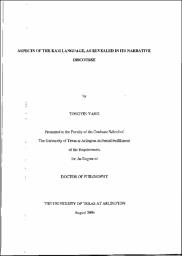
ATTENTION: The works hosted here are being migrated to a new repository that will consolidate resources, improve discoverability, and better show UTA's research impact on the global community. We will update authors as the migration progresses. Please see MavMatrix for more information.
Show simple item record
| dc.contributor.author | Yang, Tongyin | |
| dc.date.accessioned | 2020-10-09T20:49:12Z | |
| dc.date.available | 2020-10-09T20:49:12Z | |
| dc.date.issued | 2004-08 | |
| dc.identifier.uri | http://hdl.handle.net/10106/29502 | |
| dc.description.abstract | Discourse analysis has long been understudied in Kam. This research aims to initiate the exploration of this new field by examining various aspects of Kam narrative discourse and reveal its structural properties through a functional approach within Schiffrin's discourse model. A newfound morpheme /e/ leads to discussion of phonological and syntactic variations from discourse perspective. The reduction of components in rhymes in directional verbs is related to not only semantic manifestation, but more importantly, to the building-up of narrative discourse. The classifier variants in the types CLSa and CLSb encode number difference, though not identical to numbers in Indo-European languages. The analysis of pronoun modifiers of kinship terms in discourse demonstrates how historical and cultural factors have been absorbed into and represented in language. The issue of word order variations is also considered within discourse. The mysterious sentence-final particles (SFPs) in Kam and other Asian languages occupies a section in which their phonological and syntactic features are examined, and the inventory of collected SFPs in published Kam linguistic data emerges. After grouping them into three different categories, the study considers both semantic and discourse functions of each individual SFP. The discussion of Kam narrative structure under Labov's model demonstrates that the storytelling setting influences the structure of the produced narration itself. The integration of the complication and evaluation is a result of storytelling being an act of public education as well as of entertainment. Furthermore, discourse grammatical characteristics of the narrative, such as repetition, are presented. The unique communicational aspect of Kam ‘monologue’ narrative leads to the discussion of social interaction, and social power in narrating. A prominent communication operator liax specifically showcases how a single linguistic unit functions at various levels of discourse structure. | en_US |
| dc.language.iso | en_US | en_US |
| dc.publisher | University of Texas at Arlington | en_US |
| dc.subject | Social sciences | en_US |
| dc.subject | Language | en_US |
| dc.subject | Literature and linguistics | en_US |
| dc.subject | China | en_US |
| dc.subject | Discourse | en_US |
| dc.subject | Kam | en_US |
| dc.subject | Minority | en_US |
| dc.subject | Narrative | en_US |
| dc.title | ASPECTS OF THE KAM LANGUAGE, AS REVEALED IN ITS NARRATIVE DISCOURSE | en_US |
| dc.type | Dissertation | en_US |
| thesis.degree.department | Linguistics | |
| thesis.degree.name | Doctor of Philosophy in Linguistics | |
Files in this item
- Name:
- Aspects of the Kam Language.pdf
- Size:
- 12.64Mb
- Format:
- PDF
- Description:
- PDF
This item appears in the following Collection(s)
Show simple item record


